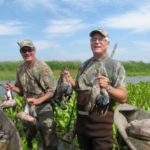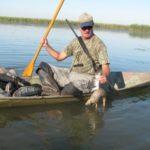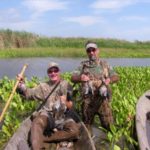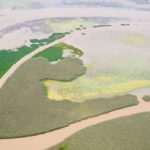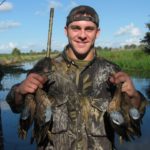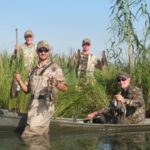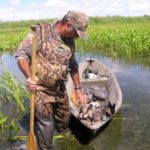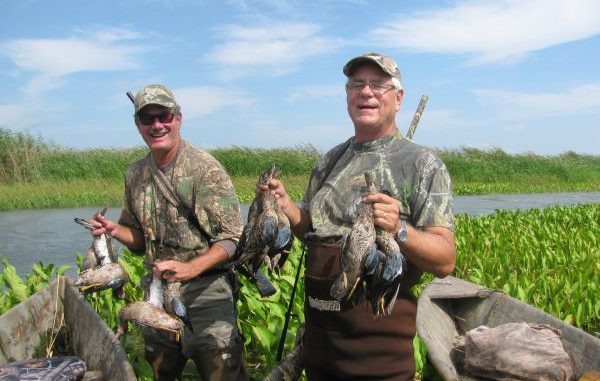
You don’t have to join the duck hunters jostle to launch for the sunrise flight of teal if you head for the mouth of the Mississippi River. Go ahead: Sleep in, let the crowds thin out and still enjoy some of the best teal-hunting in the country.
Kenny gaped — then he looked around the room frowning, his eyes like cue balls. Suddenly he smiled, reached into the cooler, and grabbed another brewskie.
“I’m in!” he laughed while popping open the beverage.
Then he waved it around the den of Doc’s Venice boathouse, toasting the whole gang.
Alas, nobody was in a toasting mood.
We’d just watched — on Doc’s spanking-new mega screen TV — the Mississippi State Bulldogs upset our Tigers 34-29.
We were hurting.
Only the prospects for the morning’s teal hunt softened the sting.
But Kenny, Spencer’s new business client, hadn’t planned to hunt. Hence his impromptu announcement.
The delta fishing in September was plenty enough for him, he’d explained earlier.
“We gonna wear out the reds, right?” he asked. “Always happened this time a year, right?”
Besides, Kenny also explained, he wasn’t exactly a hard-core duck hunter, though he did dabble in the sport — mostly as a business ritual.
Indeed, over in the Lake Charles area, where Kenny has lived since moving from Houston shortly after Katrina, such dabbling in duck-hunting is almost obligatory. Duck blinds often serve the same purpose business-wise as the golf course or Rotary Club in other parts of the South.
So Ken had dutifully spent many sunrises in a comfy permanent blind, decked out in immaculate camo clothes, blasting his immaculate over-and-under at ducks called over permanent decoy spreads by expert, earnest, soft-spoken guides and promptly retrieved by amazingly obedient dogs.
Then he got back in his Beemer ad was in his office by 9 — often without needing to shower.
He’d hardly exerted himself, after all. And he was still immaculate of the slightest splatter of mud.
“Don’t work dat way out here!” Artie laughed after Kenny described his latest rice-field teal hunt.
“Sure DON’T!” Pelayo roared, as the room erupted in boozy mirth.
Pelayo was over in the corner, at Doc’s computer.
“So what happened to your fancy new iPad?” Doc asked Pelayo. “Watcha doing on my Mac? Thought you said your iPad did it all?”
“I need a big screen for this, Doc,” Pelayo answered. “I’m scouting. I really need to study the details on this here Google map —you follow me, Doc? Ya unnerstan’ what I’m saying?”
Doc shrugged, reclined deeper into his La-Z Boy and sipped his red wine.
Meanwhile Artie, Chris and I walked toward Pelayo and poised ourselves to look over his shoulders. Sure enough, the big screen made the Google map of the upper South Pass area pretty detailed.
“Here’s what we want to zero in on for tomorrow,” Pelayo whispered conspiratorially, while pointing at a light section of marsh created by a new spillway off South Pass. “That’s a new delta.”
He winked.
“Ya follow what I’m saying? Ya unnerstan’?” Pelayo asked. “And dat’s what teal love. When the duck potato, three-square grass and wild millet starts sprouting in these areas, the high tide covers it and those little seeds from these favored duck foods just cover the surface of the marsh.
“So on the high tide the teal swarm in to feast. Tomorrow we got a high tide at 6 in da morning. Sure, they munch-out on both, but teal prefer seeds to submerged vegetation. Heck, hunting such places on a high tide (he tapped the computer screen) is almost like hunting over bait.
“Wouldn’t be surprised if they outlaw it soon. Let’s take advantage of it while we can! I plan on being there in da morning to ambush ’em? Anybody coming?”
The question, of course, was rhetorical. At least four of us (including the recently recruited Kenny) were coming — and with bells on.
It was Pelayo’s definition of “in da morning” that amazed and elated Kenny.
“We wanna be set up by about 8:30 or 9,” Pelayo announced. “So let’s get up at 7.’’
“What?’ Kenny laughed. “Shoot man! I’ll get to sleep later for a duck hunt than I do on weekdays! For our rice-field hunts we’re in the blinds before sunrise. Most of the shooting comes 15 to 20 minutes later!”
“Don’t work dat way out here!” Artie laughed again.
Not that plenty shooting wouldn’t be had with a sunrise setup. But in our experience, and given the weather forecast, dawn would be pretty calm.
Typically, the wind picks up later in the morning, along with boat traffic from fishermen heading down the passes. Both of these events usually stir up the birds for good late-morning hunting — after a decent night’s sleep and without a harrowing nighttime boat ride in the Mississippi River.
“Sure,” Pelayo added as he stood, looked around and frowned. “Hunting down there means a longer boat haul than hunting across the river in Baptiste Collette area.
“But ain’t no way I’m going through that Baptiste clown show ever again! Unn-Unnh!
“Down at Pass-A-Loutre we get a genuine hunt, with birds that actually work and without the hassles of 50,000 idiots blazing through your decoys with their surface drives, then skybusting all morning. No way! It’s well worth an extra 20-minute boat ride, if you ask me.”
Noboby argued with Pelayo. We were pumped!
Since the “special teal season,” (as it was first called) started back in 1968, the aerial duck counts for Louisiana have shown one thing consistently — the greatest concentrations of teal, by far, in Southeast Louisiana cram into the Mississippi Delta.
Lately it’s gotten worse (or better, depending on your viewpoint). Most of the teal tend to concentrate in the rice fields around Welsh in extreme western Louisiana and in the Mississippi Delta in the extreme east.
Kenny had tasted the former. Now he was primed for the latter.
That same super-high river that played havoc with our delta fishing and Breton Sound coastal fishing the last couple of years does have its upside — for duck-hunters, that is.
The high river creates new mini-deltas off the major spillways that sprout in prime duck fodder.
As a bonus, it makes the area walkable. Picking up and setting out dekes and retrieving ducks while walking in Southeast Louisiana marsh: Who ever heard of such a thing?
Many of us who hunt the Mississippi delta, that’s who.
Teal prefer shallow, fresh marsh. And, like most puddle ducks (except gadwall), they prefer feeding on seeds rather than underwater vegetation.
In September in the Delta, teal find the best of both.
By Thanksgiving, the duck potato plants have mostly wilted, and pintail and geese flock to the sites to root for the tubers in the mud.
But in September, they’re providing seeds for the teal, mottled ducks and impatient pintail.
Best of all, thick stands of wild millet still stand in September. This stuff is like corn, wheat or rice for wild ducks. When that tide comes up, all those little seeds float to the surface and the teal pour in to feast.
You want to be near one of these spots when it happens, believe me.
It’s very similar to rice-field teal hunting — but doesn’t require a sunrise setup.
Alas, the entire Delta is not uniformly blanketed with teal. For whatever reason (my guess is the prevalence of these new, shallow mini-deltas that sprout in their favorite fodder), the legally huntable areas in the Delta National Wildlife Refuge and the new sandbars off South Pass on Pass-A-Loutre WMA usually hold the most teal.
So, as usual, we opted for “the second shift” of teal hunting, as we call it.
At 7:45 a.m., we were just turning into South Pass from the river. The air was fragrant with peavine and elephant ears, a smell that screams “teal limits followed by reds and flounder” to those of us who come down in September — the peak season for those three species.
A glorious outdoor ambiance, amigos.
Pelayo was at the helm, pointing toward the vibrant green marsh with a smile a mile wide.
“They probably limited out already,” Pelayo leaned over and said to a perplexed Kenhy, who pointed at the third boatload of hunters passing us on their way back upriver. “We prefer to hunt the second shift: less crowded, more ducks flying, more sleep.”
Kenny frowned, and then laughed. He seemed to be catching on.
We turned right about two miles down South Pass, planning to set up no more than a quarter of a mile down the skinny pass we’d “scouted” from Doc’s boathouse.
As mentioned, for teal there’s no need to hunt the big expanses of water with the roseau islands. We hunt those locations on low-tide situations for pintail and greys during the big season.
Now — on a high tide — we wanted the flooded mini-deltas that amount to a teal food-orchard.
We were enraptured as we turned into the spillway Pelayo had so carefully “scouted” the previous night.
Kenny seemed stunned.
“Where’s all the teal?” he asked. “I mean, out by Welch right now I bet the sky’s full of them — but I don’t see a one around here?”
Just then two mottled ducks sprung from the flooded duck potato on our left, quacking loudly.
“Summer French,” Artie pointed. “You’ll be seeing plenty of ’em decoying today. But don’t shoot em, OK Ken?
“Wait for us to identify and shoot first. Sometimes dem young summer French look kinda like an old teal without his winter plumage — ya follow me?”
“I know, I know,” Ken nodded.
Then they erupted.: A huge flock of maybe 50 or 60 teal that had been huddled up munching out on the seeds in the flooded grass not 60 yards in front of us.
“Whoo-YAH!” Kenny roared.
Then another small flock from our left. Then another from farther up.
Yes!
Flocks of teal suddenly filled the air around us — dipping, rising, swerving, now shooting skyward as — blam! blam! — some distant shots echoed across the marsh.
But the fusillade was nothing like what was probably going on around Baptiste Collete at the time.
The bigger mottled ducks, mostly in pairs, were almost as numerous. And way up there, looked like — yep — pintail in a ragged V formation.
A shallow, weedy, seedy pond surrounded by wild millet, three-square and duck potato loomed just ahead. We beached the boat and got to work.
“Get cracking, Ken!” Artie yelled. “This ain’t Welch! No butlers and valets for ya here!”
Artie and I set out the 20 decoys from the “decoy ’rogue,” as Pelayo and a laughing Kenny jammed the second “shooting ’rogue” into some bulrushes and stuck a few palmettos around it.
The first shots rang out before the setup was even complete.
“Nice shot!” I howled as Kenny folded a single flying directly overhead, which almost landed in our ’rogue.
Pelayo and Kenny had downed three by the time Artie and I finally joined them.
“Mind if we take a turn?!” Artie snarled.
“Down!” Pelayo answered, as we nestled onto the “shooting bench” that fits lengthwise in the shooting ’rogue.
Yep. A huge flock — maybe 30 birds — had seen the dekes and were making a wide circle.
Geezum, what a sight. Eight months of anticipation glowed from every face. Trigger fingers tapped safeties. I even noticed a speck of mud on Kenny’s fancy over-and-under!
Anxious eyes followed the flock as it neared. As it swerved. Back. Forth.
It was too much for the nervous system. I had to stifle a guffaw.
Not yet — not yet — OK — Now!
Blam-blam-blam! Blam-blam!
The teal rocketed skyward above us, and we wrenched our necks trying to follow them.
Blam! Blam!
Ten shots — and a grand total of two teal fell from the fusillade into the perimeter of the dekes.
We were in hysterics.
“We waited too long!” I howled. “Geezum! Will we never learn?”
Moral of the story: Let big ducks get as close as possible before rising. They backpedal with the wind and are out of range in seconds.
Teal, on the other hand, rocket skyward right over you. So it’s best to get up before they hit the edge of the dekes.
But no time for recriminations.
“On the left!” Artie pointed.
Ah, yes. Five winging in low — gliding — wings just cupping.
“Now!” I hissed.
We got up, and the birds shot skyward.
But at 25 yards, they presented perfect targets — like a shooting gallery.
Blam-blam! Blaam!
Four fell.
“Now we’re getting somewhere!” Kenny hooted.
The whoops and high-fives lasted another two minutes. Then more shooting, as a flock of four blazed in from the left.
All four stayed with us as we high-fived and feathers floated over the water’s surface.
Many more flocks were visible around us, a couple of them already zeroing in on our dekes.
Sure enough — those roseaus were swaying. That late-morning wind had the ducks stirred up.
By 11:05 we’d limited out — 24 teal.
“OK, gang: Time for the reds and flounder along the river riprap near the mouth of Baptiste Collette,” Pelayo announced.
And so we unloaded the guns and started walking around picking up the dekes, an astoundingly easy process by our standards.
But a grueling one by Kenny’s.
“Hey, Ken!” Artie suddenly pointed at our guest. “Is that mud on your shirt?”
We roared with mirth as Ken wiped at it with his camo kerchief.
